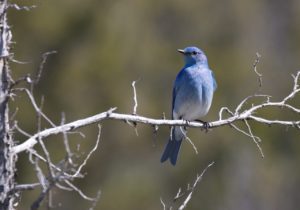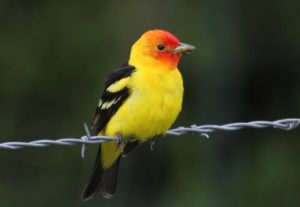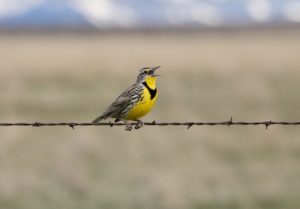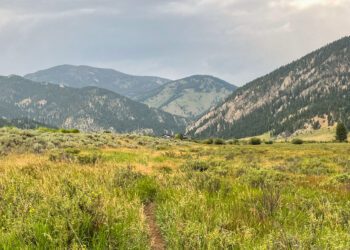By Jessianne Wright EBS Contributor
This April, many birds will return to the alpine terrain of Big Sky. Some species simply move from higher to lower elevations on the mountains, while others travel thousands of miles from winter feeding grounds to summer breeding grounds.
EBS spoke with Lou Ann Harris, a member of Bozeman’s Sacajawea Audubon Society, to learn more about a selection of migratory birds that are returning to Gallatin County. Here is what she had to say.

Wingspan: 12 inches
Weight: 1.1 ounces
Against the backdrop of a dull, brown Montana landscape, the blue flash of a male mountain bluebird is a welcome sign of spring. The mountain bluebird winters in New Mexico and Texas and begins its spring migration early, with the males arriving in late February or early March.
Once the male establishes his breeding territory, he waits for a female to come around, courting her by singing, flight displays or offers of food. Female bluebirds select a mate based on the location and quality of the nesting cavity he offers her, not on his appearance or singing ability.
The mountain bluebird’s diet consists mostly of insects, with a preference for caterpillars and grasshoppers. In the winter and early spring, they will eat small fruits, seeds and earthworms. The birds use a foraging technique called “sallying” in which they fly down from a perch to snatch an insect on the ground, returning to a perch to eat.
Bluebirds are secondary cavity nesters, meaning they use old woodpecker holes to nest. In the absence of natural cavities, they will use manmade nest boxes.
Sacajawea Audubon members maintain and monitor over 300 bluebird boxes in Gallatin County and also band nestlings and adult females. Recaptures of banded bluebirds show that the same birds return every year to the same nesting territories and sometimes to the exact same nest box.

Wingspan: 11.5 inches
Weight: 0.98 ounces
There are not very many birds that breed in Montana that can beat the Western tanager for its sheer gaudy plumage.
The male sports a bright yellow body, an orange-red head and black wings, back and tail. The female is more understated, with a gray back and greenish-yellow rump and nape.
They primarily eat insects during the nesting season, especially wasps, grasshoppers, beetles and dragonflies. Before swallowing dragonflies, the birds clip off the bug’s wings, and sometimes the legs and head as well.
This long-distance migrant spends its winters in Mexico and Central America. It migrates north at night, usually alone or in small flocks.
Western tanagers range farther north than any other tanager, breeding northward to a latitude of 60 degrees, where they spend as little as two months before migrating south. In Montana, these birds nest in open coniferous forests.
The song of the Western tanager is reminiscent of an American robin, but shorter and raspier in tone.

Wingspan: 16 inches
Weight: 3.6 ounces
The flutelike song of the Western meadowlark, Montana’s state bird, is always a welcome sound in the spring. This chunky robin-sized songbird is often more easily heard than seen.
The meadowlark is a bird of native grasslands, prairies and agricultural fields.
It is a colorful member of the blackbird family, with a bright yellow breast crossed with a black “v.”
Meadowlarks are ground nesters. The female uses her bill to shape a cup-like depression in the soil, often using an animal’s footprint to start. She then lines the hole with soft, dry grasses and pliable stems. She will sometimes create a waterproof dome over the nest by weaving together grass and shrub stems. This will take her 6-8 days to complete.
Meadowlarks are varied in their diet. They will forage for grain in winter and early spring, insects in late spring and summer, and weed seeds in the fall. During hard winters, they may even feed on roadkill.
Like other blackbirds, meadowlarks use a feeding behavior called “gaping.” This involves inserting their bill into the soil and forcing it open to create a hole, giving them access to insects that most birds can’t reach.
Lou Ann Harris is a member of the Sacajawea Audubon Society in Bozeman and has been an avid bird lover since 1997. She honed her birding skills in Washington state, learning to identify most species by their calls and songs. Sacajawea Audubon hosts numerous bird-related events, classes and field trips. For more information, visit sacajaweaaudubon.org.












